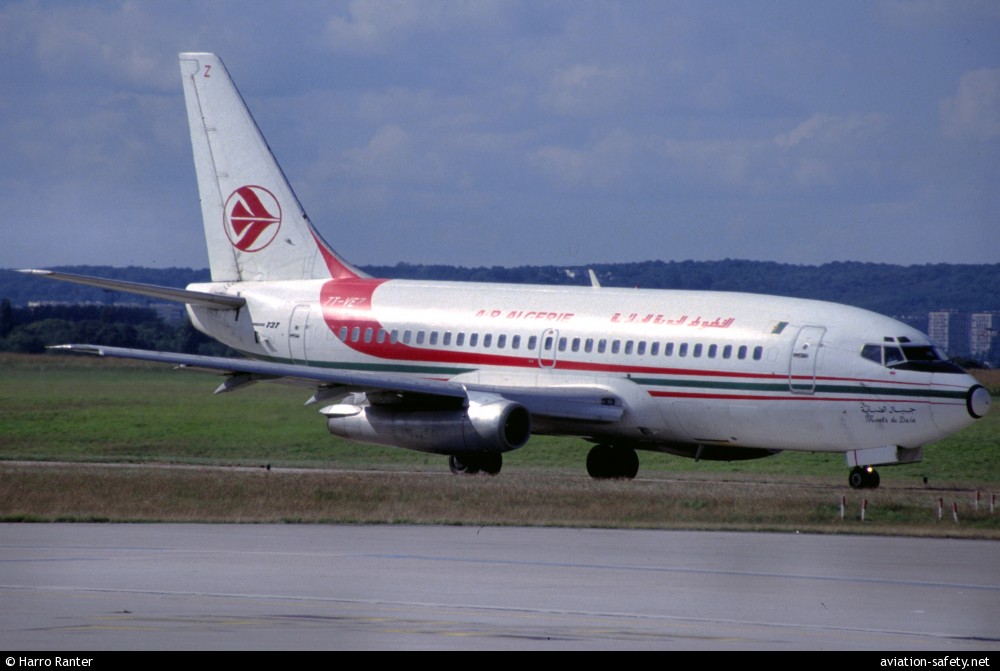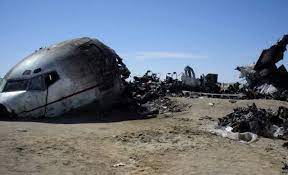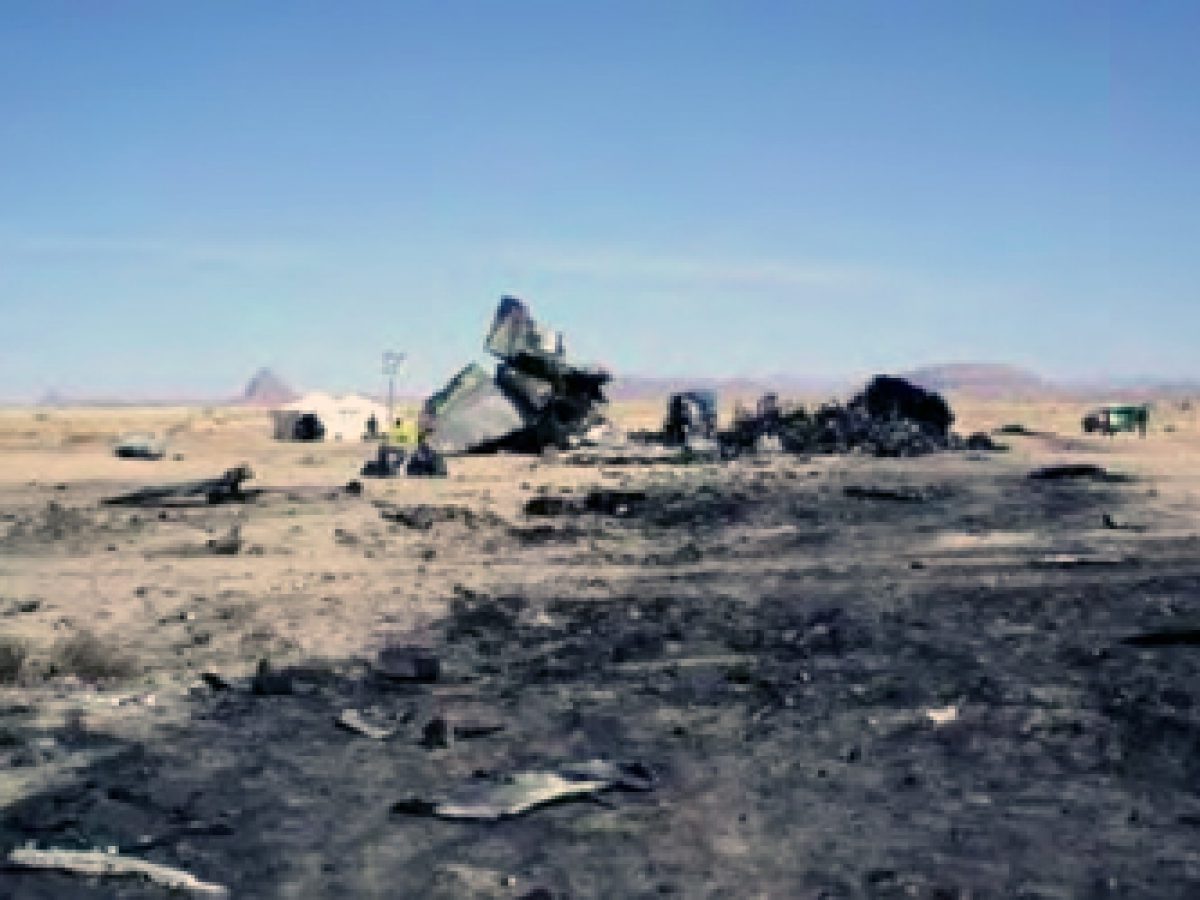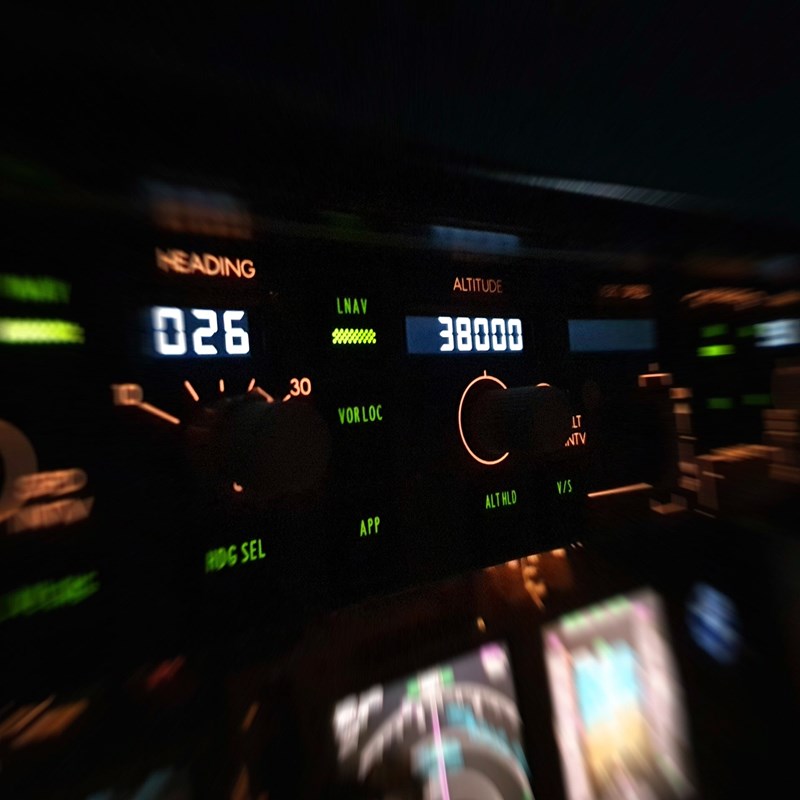06 March 2003 - Air Algérie 6289
On Thursday 6 March 2003, the Boeing 737-200 registered 7T-VEZ, operated by Air Algérie, was taking off from Tamanrasset to undertake, with a three-hour delay, a scheduled flight DAH 6289 to Ghardaïa and Algiers. Six crew members (two flight crew and four cabin crew) and 97 passengers were on board. The co-pilot was pilot flying. No technical exemptions or deferred maintenance items applied to the airplane; on departure from Algiers it had been subject to routine maintenance for a minor technical problem, a hydraulic pump having been changed in the circuit B landing gear bay.

The speeds decided on by the crew were V1 = 144 kts (267 km/h; 166 mph), VR = 146 kts (270 km/h; 168 mph), V2 = 150 kts (280 km/h; 170 mph). The EPR displayed was 2.18, (nominal maximum thrust on take-off).
About five seconds after the airplane left the ground, at the moment when gear retraction was requested, a sharp thumping noise was recorded on the CVR. The airplane’s heading veered to the left, followed by a track correction. The Captain announced that he was taking over the controls. A short time later, the co-pilot told the control tower “we have a small problem”. The airplane continued to climb and reached a recorded height of about 400 ft (120 m).
The speed dropped progressively from 160 kn (300 km/h; 180 mph) during lift-off, to stall speed at the end of the recording. In fact, about ten seconds before the crash, the noise of the stick shaker is heard on the CVR (which usually indicates that the airplane is 7% from its stall speed). The aural warning, which normally indicates a radar altitude below 200 ft (61 m), appeared about six seconds before the end of the recording.
The airplane, with landing gear extended, struck the ground on its right side. A severe fire broke out immediately. The airplane slid along, losing various parts, struck and knocked over the airport perimeter fence then crossed a road before coming to a halt in flames. An alert was immediately sounded by the control tower.
All but one of the 97 passengers and all of the six crew members perished, a total of 102 people. The only survivor of the accident was 28-year-old Youcef Djillali.

Investigators noted the lack of preparedness on the part of the aircrew and the unsuitability of the rocky ground near the airfield for emergency landings. The lack of co-ordination between the pilots at the moment when tasks were transferred meant the Captain had to manage an emergency situation, which he had not had time to analyze completely. For the same reasons, he did not rely on the co-pilot, whom he simply asked on several occasions to let go (of the controls). He likely encountered some problems in taking over control, given that he repeated the terms “let go” and “take your hand off”, this continuing until the end of the recording. The co-pilot appears to have carried out the Captain’s orders by reading back in the affirmative and indicating her willingness to act (proposal to retract the gear, radio message to the tower with the hand mike) though without being sure of the role she was supposed to play. This may, for example, have resulted in her placing her hands on the control column at the time of the stall warning alarms, which would explain the repeated requests from the Captain. She was thus not fully carrying out her role as PNF and did not monitor or at least call out the speeds as they were decreasing. The co-pilot’s offer to retract the gear was probably not even noticed by the Captain, due to his sudden excess workload.
According to the airline’s procedures, the initial climb on one engine should be performed with the gear retracted, maintaining safety speed at V2 until the safety altitude. However, the landing gear was never retracted. With the conditions on the day of the accident. Calculations and simulations performed by investigators show that it would have been difficult, or even impossible, to maintain a positive rate of climb. As the altitude continued to increase the airspeed inevitably dropped below safe limits for that configuration.
The Captain took over the flight controls in a critical situation while he was out of the loop with regard to flying. This probably led him to focus on a pitch attitude that was incompatible with one failed engine. His decision to take over the controls made it impossible for him to develop and supervise a strategy to adopt for the conduct of the flight.
The left engine failure coincided with the co-pilot’s request to retract the landing gear and disrupted that action. The co-pilot mentioned retracting the gear again but, at that moment, the task-sharing had been reversed. It was up to the Captain to ask for gear retraction. In the end, the gear remained extended until the impact.
The airplane’s aerodynamic performance subsequently deteriorated rapidly, especially as a result of the non-retraction of the gear, which added to the effect of maintaining a high pitch attitude. In addition, it should be emphasized that the high altitude of the aerodrome and the high temperature on the day, as well as a take-off weight close to the maximum also contributed to limiting the airplane’s performance. During the initial climb, the high pitch attitude and the yaw induced by the failure of the left engine (which had the effect of increasing the drag at a critical moment), added to the factors previously mentioned.
The high pitch attitude and loss of speed put the airplane in a stall situation. About fourteen seconds after the noise and the “gear up” callout, the stick shaker began to operate intermittently, then continuously, until the end of the recording. The “don’t sink” aural warning told the crew that the airplane was dropping. The pitch attitude was apparently maintained until impact with the ground, as examination of the site showed. On the wreckage, the horizontal stabilizer trim was found in the position for a normal takeoff, which tends to support this hypothesis.

Extract from the CVR Transcript:
Flight preparation was carried out by the co-pilot alone. At her request, the Captain authorized her to perform the flight leg.
The chief steward was present in the cockpit from time to time during flight preparation and during the take-off. He was talking with the Captain.
The copilot began the pre-take-off briefing by announcing the speeds for V1 (144 kt), VR (146 kt) and V2 (150 kt); she was interrupted by the Captain.
At 14h 12 min 47, the crew was authorized to line up on runway 02 and to take off. The wind, as given by the tower controller, was 330° at 12 kt.
Note: during communications with ATC, the crew was using hand mikes.
At 14 h 14 min 47, that is fifty-two seconds after engine power-up, the Captain announced rotation, at about 150 kt. The magnetic heading was 020°.
At 14 h 14 min 51, the speed of the plane reached 160 kt; it subsequently fell until the end of the flight.
At 14 h 14 min 52, the copilot asked for landing gear retraction (Gear Up callout). This request was immediately followed by a sharp thumping noise. The airplane's speed was then 158 kt, its height in relation to the threshold of runway 02 was 78 ft and its magnetic heading was 018°.
The plane veered to the left at magnetic heading 008°. A series of exclamations from the co-pilot, followed by "what' s going on" is heard.
Note: from the FDR data, the vertical speed on initial climb was calculated as between 1,400 and 1,800 ft/min.
From 14 h 15, the Captain asked the co-pilot several times to let go of the controls. The co-pilot read back and, three seconds later, spoke to the Captain and offered to retract the landing gear. There was no response.
At 14 h 15 min 04, the co-pilot told the controller "we have a small problem".
At 14 h 15 min 06, the stick shaker is heard for one second. The airplane's height in relation to the runway 02 threshold was then at its maximum (398 ft). Its speed was 134 kt.
At 14 h 15 min 08, the stick shaker is heard for a half second.
At 14 h 15 min 10, a GPWS "Don't Sink" aural warning is heard. From that moment on, the stick shaker is heard continuously until the end of the recording.
At 14 h 15 min 15, a second GPWS "Don't Sink" aural warning is heard. The two recorders stopped just after that. The airplane's height in relation to the runway 02 threshold was then 335 ft, its speed was 126 kt and its magnetic heading 005°.
DOWNLOAD the full Accident Investigation Report

